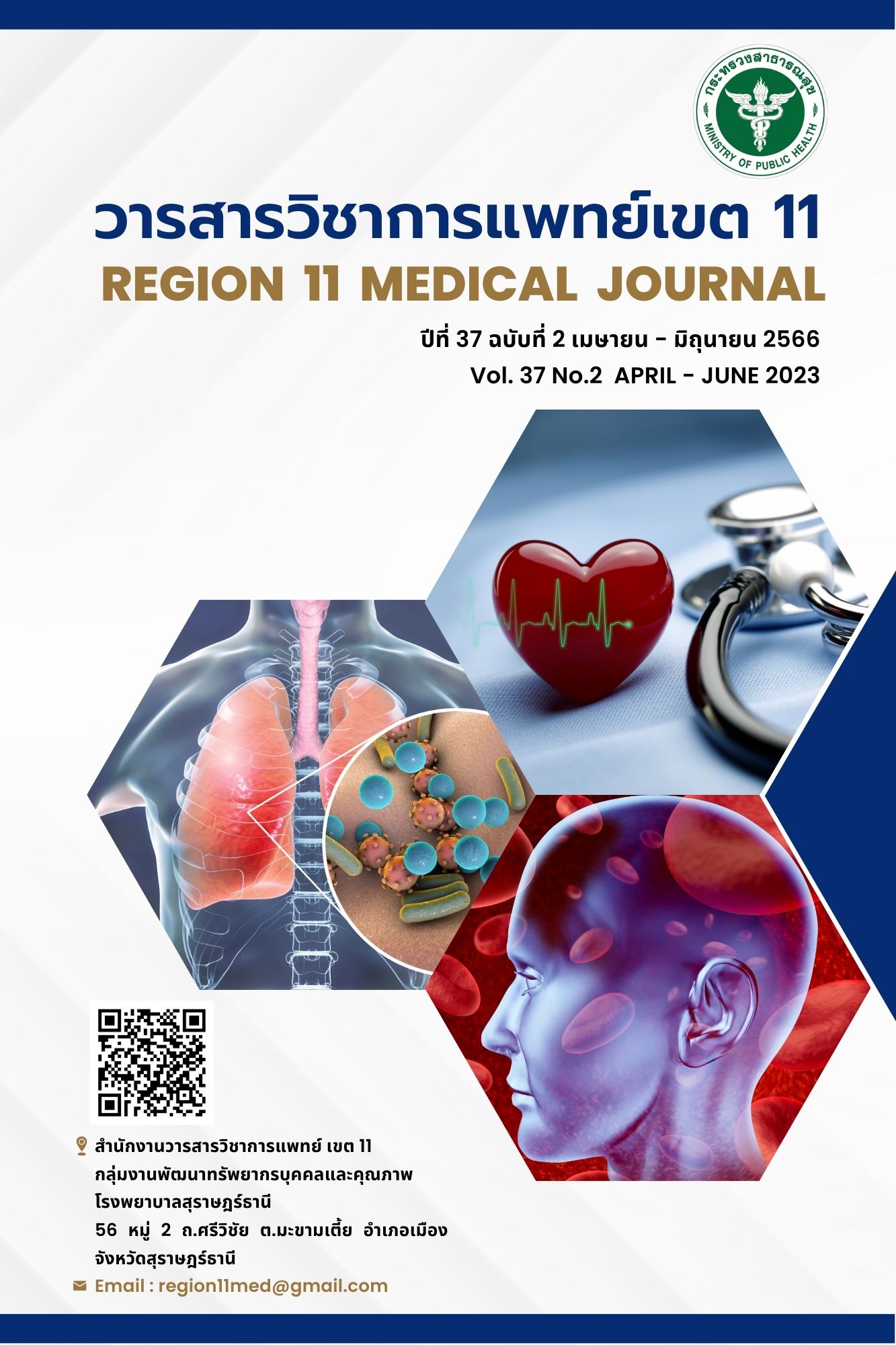Uterine massage Prior Placental Delivery During Cesarean Section and Perioperative Blood loss in Women at Risk of Uterine Atony
Keywords:
Uterine Massage, Placental Delivery, Cesarean section, Perioperative blood loss, Uterine atonyAbstract
Background: Postpartum haemorrhage (PPH) is the major cause of maternal death. Uterine atony is the most common cause of PPH. Although uterine massage is a method for preventing PPH in vaginal delivery, the effectiveness of uterine massage for preventing PPH in C-section remain unclear.
Objective: To determine the efficacy of uterine massage in avoiding PPH before placenta delivery in caesarean section in women at risk of uterine atony.
Method: We conducted a prospective cohort study design. From July to September 2022, 80 pregnant women at high risk of atonic uterus who delivered with C-section were enrolled and randomly assigned into 2 groups: patients who underwent uterine massage before delivery of placenta (study group, N=40) and who did not have uterine massage prior to placenta delivery (control group,N=40). Outcomes were incidence of PPH, intractable PPH and blood loss amount within 2 hours after delivery.
Results: The incidence of PPH and intractable PPH did not differ significantly between the study and control groups (2.5% vs. 7.5%, P=0.328; 2.5% vs. 2.5%, P=0.077). In comparison to the control group, the amount of blood loss within two hours was reduced in the study group (P0.001).
Conclusion: Uterine massage before delivery of the placenta in caesarean section did not prevent PPH in women at risk of uterine atony, but it did minimize blood loss in them
References
Balki M, Wong CA. Refractory uterine atony: still a problem after all these years. Int J Obst Anesth 2021; 48:103207.
Grobman WA, Bailit JL. Rice MM et al. Frequency of and factors associated with severe maternal morbidity. Obstet Gynecol 2014;123:804
WHO recommendations for the prevention and management of postpartum hemorrhage. World Health Organization:2012
Evensen A, Anderson JM, Fontaine P. Postpartum hemorrhage prevention and treatment. Am Fam Physician 2017;95:442-9
Larsson C, Saltvedt S, Wiklund I, Pahlen S, Andolf E. Estimation of blood loss after cesarean section and vaginal delivery has low validity with a tendency to exaggeration. Acta Obstetricia et Gynecologica. 2006; 85: 1448-52
Altraigey A, Ellaithy M, Atia H, Ali I, Kolkailah M, Abbas A. How can methods of placental delivery in cesarean section affect perioperative blood loss? A randomized controlled trial of controlled cord traction versus manual removal of placenta. Obstet Gynecol 2019;45:133-40
Kamel A, EI-Mazny A, Salah E, Ramadan W, Hussein AM, Hany A. Manual removal versus spontaneous delivery of the placenta at cesarean section in developing countries: a randomized controlled trail and review of literature. The Journal of Maternal fetal & Neonatal Medicine2018;31(24):3328-33
Zhang S, Fu X. Uterine massage to reduce blood loss before delivery of the placenta in caesarean xection: A retrospective cohort study. Z Geburtshilte Neonatol 2021;225(05):428-31
Cunningham FG, Leveno KJ, Dashe JS, Hoffman BL, Spong CY, Casey BM. Management of Obstertrical Hemorrhage. In: Cunningham FG, Leveno KJ, Dashe JS, Hoffman BL, Spong CY, Casey BM, edtors. Williams Obstertrics.26th ed. New York: Mc Graw Hill; 2022.p.770-82
Althabe F, Aleman A, Tomasso G et al. A pilot randomized controlled trial of controlled cord traction to reduce postpartum blood loss.Int J Gynecol Obstet 2009;107:4-7
Khan KS, Wojdyla D, Say L et al. WHO analysis of causes of matenal death;a systematic review. Lancet2006;367:1066-74
Prevention and management of postpartum hemorrhage. BJOG2016;124:e106-49
ACOG Committee on Practice Bulletins-Obstetrics Practice bulletin no.183: Postpartum hemorrhage. Obstet Gynecol 2017;130:e168-81
Erkaya R et al. Uterine massage to reduce blood loss after vaginal delivery. Health Care For Women International,2021;1-17
Saccone G, Caissutti C, Ciardulli A, Abdel-Aleem H, Hofmeyr GJ, Berghella V. Uterine massage as part of active management of the third stage of labor for preventing postpartum hemorrhage during vaginal delivery: a systematic review and meta-analysis of randomized trials. BJOG2018;125:778-81
Cernadas M, Smulian JC, Giannina G, et al.Effects of placental delivery method and intraoperative glove changing on post cesarean febrile morbidity. J Matern Fetal Med. 1998;7(2):100-4
Gol M, Baloglu A, Aydin C, et al. Does manual removal of the placenta affect operative blood loss during cesarean section? Eur J Obstet Gynecol Reprod Biol.2004;1112(1):57-60
Bose P,Regan F, Paterson-Brown S. Improving the accuracy of estimated blood loss at obstetric hemorrhage using clinical reconstructions. BJOG 2006;113L919-24
Downloads
Published
How to Cite
Issue
Section
License
Copyright (c) 2023 Region11Medical Journal

This work is licensed under a Creative Commons Attribution-NonCommercial-NoDerivatives 4.0 International License.






